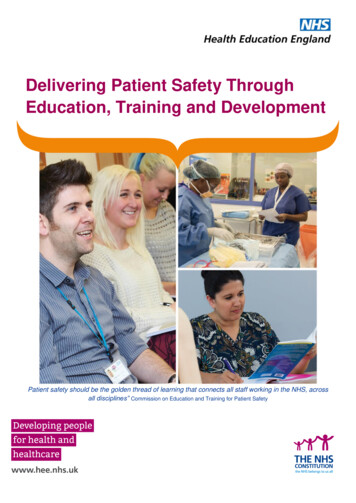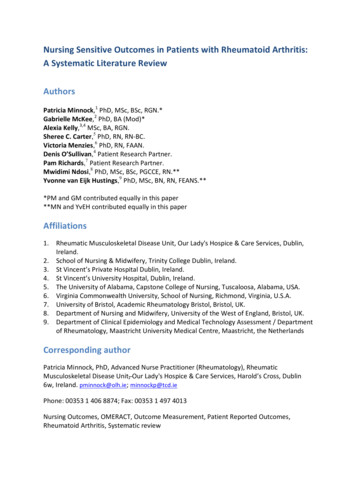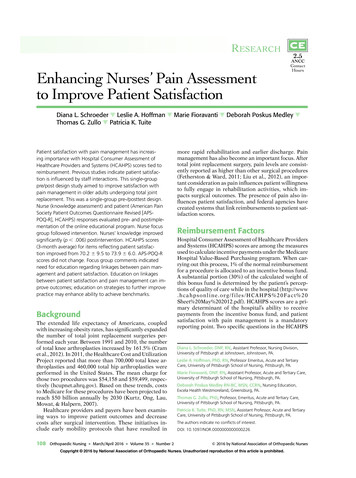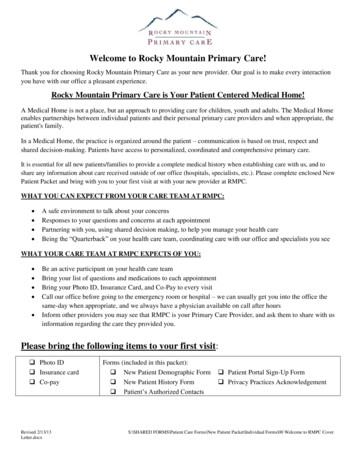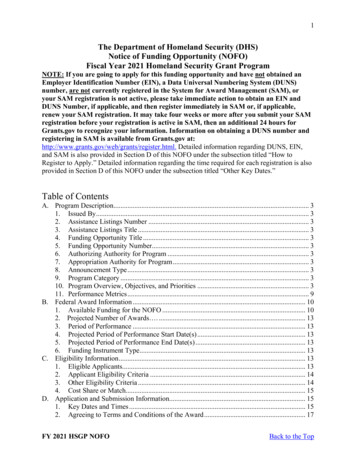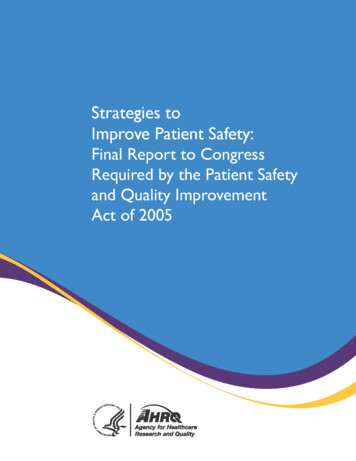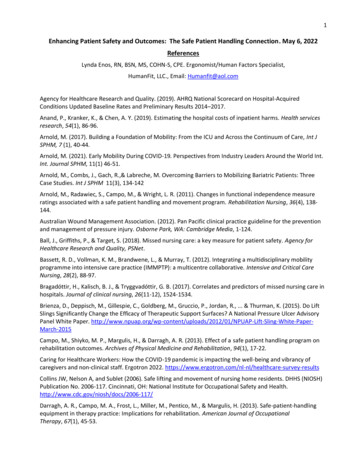
Transcription
1Enhancing Patient Safety and Outcomes: The Safe Patient Handling Connection. May 6, 2022ReferencesLynda Enos, RN, BSN, MS, COHN-S, CPE. Ergonomist/Human Factors Specialist,HumanFit, LLC., Email: Humanfit@aol.comAgency for Healthcare Research and Quality. (2019). AHRQ National Scorecard on Hospital‐AcquiredConditions Updated Baseline Rates and Preliminary Results 2014–2017.Anand, P., Kranker, K., & Chen, A. Y. (2019). Estimating the hospital costs of inpatient harms. Health servicesresearch, 54(1), 86-96.Arnold, M. (2017). Building a Foundation of Mobility: From the ICU and Across the Continuum of Care, Int JSPHM, 7 (1), 40-44.Arnold, M. (2021). Early Mobility During COVID-19. Perspectives from Industry Leaders Around the World Int.Int. Journal SPHM, 11(1) 46-51.Arnold, M., Combs, J., Gach, R.,& Labreche, M. Overcoming Barriers to Mobilizing Bariatric Patients: ThreeCase Studies. Int J SPHM 11(3), 134-142Arnold, M., Radawiec, S., Campo, M., & Wright, L. R. (2011). Changes in functional independence measureratings associated with a safe patient handling and movement program. Rehabilitation Nursing, 36(4), 138144.Australian Wound Management Association. (2012). Pan Pacific clinical practice guideline for the preventionand management of pressure injury. Osborne Park, WA: Cambridge Media, 1-124.Ball, J., Griffiths, P., & Target, S. (2018). Missed nursing care: a key measure for patient safety. Agency forHealthcare Research and Quality, PSNet.Bassett, R. D., Vollman, K. M., Brandwene, L., & Murray, T. (2012). Integrating a multidisciplinary mobilityprogramme into intensive care practice (IMMPTP): a multicentre collaborative. Intensive and Critical CareNursing, 28(2), 88-97.Bragadóttir, H., Kalisch, B. J., & Tryggvadóttir, G. B. (2017). Correlates and predictors of missed nursing care inhospitals. Journal of clinical nursing, 26(11-12), 1524-1534.Brienza, D., Deppisch, M., Gillespie, C., Goldberg, M., Gruccio, P., Jordan, R., . & Thurman, K. (2015). Do LiftSlings Significantly Change the Efficacy of Therapeutic Support Surfaces? A National Pressure Ulcer AdvisoryPanel White Paper. UAP-Lift-Sling-White-PaperMarch-2015Campo, M., Shiyko, M. P., Margulis, H., & Darragh, A. R. (2013). Effect of a safe patient handling program onrehabilitation outcomes. Archives of Physical Medicine and Rehabilitation, 94(1), 17-22.Caring for Healthcare Workers: How the COVID-19 pandemic is impacting the well-being and vibrancy ofcaregivers and non-clinical staff. Ergotron 2022. esultsCollins JW, Nelson A, and Sublet (2006). Safe lifting and movement of nursing home residents. DHHS (NIOSH)Publication No. 2006-117. Cincinnati, OH: National Institute for Occupational Safety and agh, A. R., Campo, M. A., Frost, L., Miller, M., Pentico, M., & Margulis, H. (2013). Safe-patient-handlingequipment in therapy practice: Implications for rehabilitation. American Journal of OccupationalTherapy, 67(1), 45-53.
2Darragh, A. R., Shiyko, M., Margulis, H., & Campo, M. (2014). Effects of a safe patient handling and mobilityprogram on patient self-care outcomes. The American Journal of Occupational Therapy, 68(5), 589-596.Dennerlein, J. T., O'day, E. T., Mulloy, D. F., Somerville, J., Stoddard, A. M., Kenwood, C., . & Hashimoto, D.(2017). Lifting and exertion injuries decrease after implementation of an integrated hospital-wide safe patienthandling and mobilisation programme. Occup Environ Med 2017;74:336–343. doi:10.1136/oemed-2015103507 fDirkes, S. M., & Kozlowski, C. (2019). Early mobility in the intensive care unit: evidence, barriers, and futuredirections. Critical care nurse, 39(3), 33-42.Dirkes, S. M., & Kozlowski, C. (2019). Early mobility in the intensive care unit: evidence, barriers, and futuredirections. Critical care nurse, 39(3), 33-42.Edger, M. (2017). Effect of a patient-repositioning device in an intensive care unit on hospital-acquiredpressure injury occurrences and cost: a before-after study. Journal of Wound Ostomy & ContinenceNursing, 44(3), 236-240.Enos L, & Hess, J. (2011) Implementing a Sustainable Safe Patient/Patient Handling Program: The OregonFacility of Choice Program. Presentation at the Governor's Safety and Health conference, Portland OregonEnos, L. (2013). Safe Patient Handling and Patient Safety: Identifying the Current Evidence Base and Gaps inResearch. Am J SPHM, 3(3), 94-102.European Pressure Ulcer Advisory Panel (2014). NPUAP-EPUAP-PPPIA Pressure Ulcer treatment & Prevention2014 Quick Reference Guide &qrgEuropean Pressure Ulcer Advisory Panel (EPUAP), National Pressure Injury Advisory Panel (NPIAP), and thePan Pacific Pressure Injury Alliance (PPPIA). Prevention and Treatment of Pressure Ulcers/Injuries: ClinicalPractice Guideline. The International Guideline, 3rd Edition (2019). http://www.internationalguideline.com/Ferguson, A., Bradywood, A., Williams, B., & Blackmore, C. C. (2020). Association of use of contract nurseswith hospitalized patient pressure injuries and falls. Journal of Nursing Scholarship, 52(5), 527-535.Fleisher, L. A., Schreiber, M., Cardo, D., & Srinivasan, A. (2022). Health Care Safety during the Pandemic andBeyond-Building a System That Ensures Resilience. The New England journal of medicine, 386(7), 609-611.Fridman, V. (2019). Redesigning a Fall Prevention Program in Acute Care: Building on Evidence. Clinics ingeriatric medicine, 35(2), 265-271.Get moving get Health Get Home. A PROGRESSIVE MOBILITY PROGRAM TOOLKIT (2020).A partnership of theHealthcare Association of New York State and the Greater New York aborative.org/focus areas/falls/docs/NYSPFP mobility toolkit.pdfGibson, K., Costa, B., & Sampson, A. (2017). Linking worker health and safety with patient outcomes.WorkSafe Victoria (WSV). The Institute of Safety, Compensation and Recovery Research (ISCRR)http://www.iscrr.com.au/ data/assets/pdf file/0006/1321719/Evidence-Review mes.pdfGriffiths, P., Recio‐Saucedo, A., Dall'Ora, C., Briggs, J., Maruotti, A., Meredith, P., . & Missed Care StudyGroup. (2018). The association between nurse staffing and omissions in nursing care: a systematicreview. Journal of advanced nursing, 74(7), 1474-1487.Growdon, M. E., Shorr, R. I., & Inouye, S. K. (2017). The tension between promoting mobility and preventingfalls in the hospital. JAMA internal medicine, 177(6), 759-760.Gucer PW, Gaitens J, Oliver JM,McDiarmid MA. Sit-stand mechanical lifts in long-term care and residentquality indicators.J Occup Environ Med. 2013;55(1):36-44.
3Gustafsson, N., Leino-Kilpi, H., Prga, I., Suhonen, R., & Stolt, M. (2020). Missed care from the patient’sperspective–a scoping review. Patient preference and adherence, 14, 383.Harwood, K. J., Scalzitti, D. A., Campo, M., & Darragh, A. R. (2016). A systematic review of safe patienthandling and mobility programs to improve patient outcomes in rehabilitation. International Journal of SafePatient Handling and Mobility, 6(4) 141-150.Hastings, S. N., Sloane, R., Morey, M. C., Pavon, J. M., & Hoenig, H. (2014). Assisted early mobility forhospitalized older veterans: preliminary data from the STRIDE program. Journal of the American GeriatricsSociety, 62(11), 2180-2184.Hessels, A. J., Paliwal, M., Weaver, S. H., Siddiqui, D., & Wurmser, T. A. (2018). Impact of Patient SafetyCulture on Missed Nursing Care and Adverse Patient Events. Journal of nursing care quality, 34(4), 287-294.Hitcho, E. B., Krauss, M. J., Birge, S., Claiborne Dunagan, W., Fischer, I., Johnson, S., . & Fraser, V. J. (2004).Characteristics and circumstances of falls in a hospital setting: a prospective analysis. Journal of generalinternal medicine, 19(7), 732-739.Hodgson, C. L., Capell, E., & Tipping, C. J. (2018). Early mobilization of patients in intensive care: organization,communication and safety factors that influence translation into clinical practice. Annual Update in IntensiveCare and Emergency Medicine 2018, 621-632.Hogh A, Baernholdt M, Clausen T. Impact of workplace bullying on missed nursing care and quality of care inthe eldercare sector. Int Arch Occup Environ Health. 2018;91(8):963–70Hospital Acquired Pressure Ulcers/Injuries (HAPU/I): 2017. Chicago, IL: Health Research & Educational ds/2017/10/2017-hapu change package 508.pdfHoulihan, S., Fernandez, N., Magnant, C., Levin, A., & Murphy, S. (2018). Evaluating a nurse-driven mobilityalgorithm for hospitalized general medicine patients: a pilot study. Journal of Acute Care PhysicalTherapy, 9(4), 179-185.Hoyer, E. H., Friedman, M., Lavezza, A., Wagner‐Kosmakos, K., Lewis‐Cherry, R., Skolnik, J. L., . & Needham,D. M. (2016). Promoting mobility and reducing length of stay in hospitalized general medicine patients: Aquality‐improvement project. Journal of hospital medicine, 11(5), 341-347.Joint Commission. (2012). Improving patient and worker safety: opportunities for synergy, collaboration andinnovation. Oakbrook Terrace, IL: The Joint Commission, s, D & Eaferton, G. (2020). Reducing Preventable Injuries Through the Safe Patient Handling and MobilityProgram Bundle. Int J SPHM, 1(4), 134-138.Kalisch, B. J., & Lee, K. H. (2012). Missed nursing care: Magnet versus non-Magnet hospitals. Nursingoutlook, 60(5), e32-e39.Kalisch, B. J., & Williams, R. A. (2009). Development and psychometric testing of a tool to measure missednursing care. JONA: The Journal of Nursing Administration, 39(5), 211-219.Kalisch, B. J., Lee, S., & Dabney, B. W. (2013). Outcomes of inpatient mobilization: a literature review. Journalof clinical nursing, 23(11-12), 1486-1501.Kalisch, B. J., Tschannen, D., & Lee, K. H. (2012). Missed nursing care, staffing, and patient falls. Journal ofnursing care quality, 27(1), 6-12.Kappel, S. E., Larsen-Engelkes, T. J., Barnett, R. T., Alexander, J. W., Klinkhammer, N. L., Jones, M. J., . & Ye, P.(2018). Creating a culture of mobility: Using real-time assessment to drive outcomes. AJN The AmericanJournal of Nursing, 118(12), 44-50.
4Kayser, S. A., VanGilder, C. A., & Lachenbruch, C. (2019). Predictors of superficial and severe hospital-acquiredpressure injuries: A cross-sectional study using the International Pressure Ulcer Prevalence survey. International journal of nursing studies, 89, 46-52.Kayser, S. A., Wiggermann, N. E., & Kumpar, D. (2020). Factors associated with safe patient handling practicein acute care and its relationship with patient mobilization: A cross-sectional study. International journal ofnursing studies, 104, 103508Kennedy, B., & Kopp, T. (2015). Safe patient handling protects employees too Nursing2018, 45(8), 65-67.King, B., Pecanac, K., Krupp, A., Liebzeit, D., & Mahoney, J. (2018). Impact of fall prevention on nurses and careof fall risk patients. The Gerontologist, 58(2), 331-340.Kjellberg, K., Lagerström, M., & Hagberg, M. (2004). Patient safety and comfort during transfers in relation tonurses’ work technique. Journal of advanced nursing, 47(3), 251-259.Kumar J. PSQH Innovation Awards Winner: SCL Health Improves Process for Prone Positioning of COVID-19Patients. Patient Safety Awareness Week Special Report. March LM/CR-5812 PSQH-PSAW eBook FINAL.pdfKurowski, A, & El Ghaziri ,M. (2019) The Role of Safe Patient Handling in Reducing Type II Workplace Violencein Healthcare Setting. CPH News and Views, Issue 61 June 2019. UMass merging-topics/News-views-62.aspxLabreche, M, Falk D, Kim OK, Patrick K, Simon B (2021) Progressive Mobility of Patients Supported on ECMOfrom Dependency to Ambulation Utilizing Safe Patient Handling Technology. .Int J SPHM 11(2), 88-97LaVigne, A., & Arnold, M. (2016). Decision making for safe patient handling and mobility technology in anearly mobility program. Am J SPHM, 6(2), 65-72.LeLaurin, J. H., & Shorr, R. I. (2019). Preventing falls in hospitalized patients: state of the science. Clinics ingeriatric medicine, 35(2), 273-283.Loeppke, R. et al. (2017). Interaction of Health Care Worker Health and Safety and Patient Health and Safetyin the US Health Care System: Recommendations from the 2016 summit. American College of Occupationaland Environmental Medicine (ACOEM) Position Statement. Journal of Occupational and EnvironmentalMedicine, 59(8), 803-813.http://www.acoem.org/uploadedFiles/Public Affairs/Policies And Position on of Health Care Worker Health and.17.pdfLustig, M., Wiggermann, N., & Gefen, A. (2020). How patient migration in bed affects the sacral soft tissueloading and thereby the risk for a hospital‐acquired pressure injury. International Wound Journal, 17(3), 631640.Marshall, V., Team, V., & Weller, C. (2021). Hospital-acquired pressure injury prevention in people with a BMIof 30.0 or higher: A scoping review protocol. Wound Practice & Research: Journal of the Australian WoundManagement Association, 29(3), 133-139.Matz, M., Celona, J., Martin, M., McCoskey, K., & Nelson, G. G. (2019). Patient Handling and MobilityAssessments, 2nd ed. Baltimore, MD: Facility Guidelines Institute. Retrieved ments 191008.pdfMcilvane et al. (2011). Integrating patient handling equipment into physical therapy activities in arehabilitation setting a case series. AJSPHM, 1(3), 16-22.McMillan, J., Moo, A., Newnam, S., & de Silva, A. (2018) Improvements in patient handling for worker andpatient safety. WorkSafe Victoria (WSV). The Institute of Safety, Compensation and Recovery Research (ISCRR)
5https://www.iscrr.com.au/ data/assets/pdf file/0004/1321771/Environmental-Scan ient-safety.pdfMissed Nursing Care AHRQ PSNet Patient Safety Primer 2019, lson, A. L. (2006). Safe patient handling and movement: A practical guide for health care professionals.Springer Publishing Company.Nelson, A., Collins, J., Siddharthan, K., Matz, M., & Waters, T. (2008). Link between safe patient handling andpatient outcomes in long‐term care. Rehabilitation Nursing, 33(1), 33-43.Park, S. H., Hanchett, M., & Ma, C. (2018). Practice environment characteristics associated with missednursing care. Journal of Nursing Scholarship, 50(6), 722-730.Park, S. H., Hanchett, M., & Ma, C. (2018). Practice environment characteristics associated with missednursing care. Journal of Nursing Scholarship, 50(6), 722-730Pihl-Thingvad, J., Brandt, L. P., & Andersen, L. L. (2018). Consistent use of assistive devices for patient transferis associated with less patient-initiated violence: cross-sectional study among health care workers at generalhospitals. Workplace health & safety, 66(9), 453-461.Plaku-Alakbarova, B., Punnett, L., Gore, R. J., & Procare Research Team. (2018). Nursing home employee andresident satisfaction and resident care outcomes. Safety and health at work, 9(4), 408-415.Potter, K., Miller, S., & Newman, S. (2021). Environmental Factors Affecting Early Mobilization and PhysicalDisability Post–Intensive Care: An Integrative Review Through the Lens of the World Health OrganizationInternational Classification of Functioning, Disability, and Health. Dimensions of Critical Care Nursing, 40(2),92-117.Preventing Falls in Hospitals. Content last reviewed March 2021. Agency for Healthcare Research and Quality,Rockville, g Pressure Ulcers in Hospitals. Content last reviewed October 2014. Agency for Healthcare Researchand Quality, Rockville, spital/resource/pressureulcer/tool/index.htmlPun, B. T., Balas, M. C., Barnes-Daly, M. A., Thompson, J. L., Aldrich, J. M., Barr, J., . & Ely, E. W. (2019). Caringfor critically ill patients with the ABCDEF bundle: results of the ICU liberation collaborative in over 15,000adults. Critical care medicine, 47(1), 3.Risør, B. W., Casper, S. D., Andersen, L. L., & Sørensen, J. (2017). A multi-component patient-handlingintervention improves attitudes and behaviors for safe patient handling and reduces aggression experiencedby nursing staff: A controlled before-after study. Applied ergonomics, 60, 74-82.Rockefeller K. (2008). Using technology to promote safe patient handling and rehabilitation. RehabilitationNursing, 33(1):5-11.Rondinelli, J., Zuniga, S., Kipnis, P., Kawar, L. N., Liu, V., & Escobar, G. J. (2018). Hospital-acquired pressureinjury: Risk-adjusted comparisons in an integrated healthcare delivery system. Nursing research, 67(1), 16.Ryan, P., Fine, C., & DeForge, C. (2021). An Evidence-Based Protocol for Manual Prone Positioning of PatientsWith ARDS. Critical Care Nurse, 41(6), 55-60.Schubert, M., Clarke, S. P., Aiken, L. H., & De Geest, S. (2012). Associations between rationing of nursing careand inpatient mortality in Swiss hospitals. International Journal for Quality in Health Care, 24(3), 230-238.
6Smart, D. A., Dermody, G., Coronado, M. E., & Wilson, M. (2018). Mobility programs for the hospitalized olderadult: a scoping review. Gerontology and geriatric medicine, 4, 2333721418808146.Spritzer, S. D., Riordan, K. C., Berry, J., Corbett, B. M., Gerke, J. K., Hoerth, M. T., . & Noe, K. H. (2015). Fallprevention and bathroom safety in the epilepsy monitoring unit. Epilepsy & Behavior, 48, 75-78.Teeple, E., Collins, J. E., Shrestha, S., Dennerlein, J. T., Losina, E., & Katz, J. N. (2017). Outcomes of safe patienthandling and mobilization programs: A meta-analysis. Work, 58(2), 173-184.Top 10 Patient Safety Concerns 2022.ECRI. s-2022Turner, R. Agarwal,N., Agarwal, S. & Best, L. (2020) Bringing Life to a Systemwide Early Mobility ClinicalPractice: Part 1 .Int J SPHM 10(4), 126-133Turner, R. Agarwal,N., Agarwal, S., Best, L., & Noble,J.(2021) Bringing Life to a Systemwide Early MobilityClinical Practice: Part 2 .Int J SPHM 11(1), 190-198Vollman, K. M. (2010). Introduction to progressive mobility. Critical care nurse, 30(2), S3-S5.Wald, H. L., Perskin, M. H., Roberts, L., Bogaisky, M., & Mikhailovich, A. The Case for Mobility Assessment inHospitalized Older alized-Older-Adults.pdfWald, H. L., Ramaswamy, R., Perskin, M. H., Roberts, L., Bogaisky, M., Suen, W., . & Quality and PerformanceMeasurement Committee of the American Geriatrics Society. (2019). The case for mobility assessment inhospitalized older adults: American Geriatrics Society white paper executive summary. Journal of theAmerican Geriatrics Society, 67(1), 11-16.Walden, C. M., Bankard, S. B., Cayer, B., Floyd, W. B., Garrison, H. G., Hickey, T., . & Pories, W. J. (2013).Mobilization of the obese patient and prevention of injury. Annals of surgery, 258(4), 646-651.Wang, J., Ren, D., Liu, Y., Wang, Y., Zhang, B., & Xiao, Q. (2020). Effects of early mobilization on the prognosisof critically ill patients: A systematic review and meta-analysis. International Journal of Nursing Studies, 110,103708.Wegmann, D. J. (2011). Comparing two identification methods of missed nursing care (Doctoral dissertation,Texas Woman's University).Wicker, P. (2000). Manual Handling: In the Perioperative Environment. British Journal of Perioperative Nursing(United Kingdom), 10(5), 255-259.Workman, C. A., Davies, C. C., Ogle, K. C., Arthur, C., & Tussey, K. (2020). Evaluation of a multisite nurse-ledmobility plan. JONA: The Journal of Nursing Administration, 50(12), 649-654.World Health organization (WHO) Towards eliminating avoidable harm in health care. Final draft GlobalPatient Safety Action Plan 2021-2030. 2021 on-planWyatt, S., Meacci, K., & Arnold, M. (2020). Integrating Safe Patient Handling and Early Mobility: CombiningQuality Initiatives. Journal of Nursing Care Quality, 35(2), 130-134.Zhang, L., Hu, W., Cai, Z., Liu, J., Wu, J., Deng, Y., . & Qin, Y. (2019). Early mobilization of critically ill patientsin the intensive care unit: A systematic review and meta-analysis. PloS one, 14(10), e0223185.
2 Darragh, A. R., Shiyko, M., Margulis, H., & Campo, M. (2014). Effects of a safe patient handling and mobility program on patient self-care outcomes.
